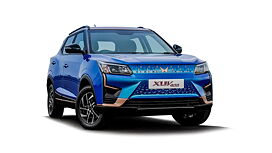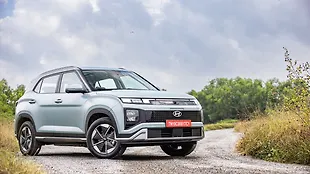Introduction
This is Mahindra’s first attempt at an EV. There was the e20 and the e-Verito, but while the former was a rebadged and slightly improved Maini Reva, the latter belonged to the time when EVs were considered a myth. So the XUV400 is a proper Mahindra and a proper EV. But is it?

This is XUV400 in the EL (that’s the bigger battery version) subjected to the usual CarWale Road Test assessment. It has also received an update with eight new feature additions which weren’t available (and should have been offered) when Mahindra first introduced it
Design
8 / 10

Resemblance to the XUV300 is present, but the XUV400 is longer and more muscular at the rear. In metal, its proportions look much better and well put together. We also love the contrast copper treatment which makes the XUV400 stand out. Overall, the XUV400 has styling in the bag. It looks special and feels out of the ordinary, and that’s a battle half won.

Part of the update is the fog lamps which weren’t offered on the pre-production model we drove earlier.
Interior Look and Quality
5 / 10

But the battle it won in the exterior styling slips out of its clutches with its interior. With a paradigm shift of EVs, this cabin feels like a cassette player in a time of online streaming. Mahindra had an opportunity to bring radical changes to the XUV400 as it has proven time and again (case in point new XUV700 and Scorpio N) but that’s not the case here.

The driver’s display has analogue needles but buyers do prefer all-digital displays these days, especially in EVs. Even the cascading centre console hasn’t changed over the XUV300. It has many buttons which modern-day cars have eradicated (into the touchscreen mostly). And the touchscreen should have kept up with time too. Especially when the direct rival – Nexon EV – has gone leagues ahead.
Space and Comfort
7 / 10

What the XUV400 manages well is offering good space on the inside. Draped in good-quality leatherette, the seats offer ample support and even spending the entire day in the saddle wasn’t too tiring. There’s good visibility all around helped by large ORVMs. With a 2600mm wheelbase, the knee room for the second row is commendable.

However since the battery is placed underneath, the seating posture is slightly awkward with a raised knee and not enough floor space for the foot with many raised bumps and cuts on the floor. Placing a proper floor mat will solve this to an extent, but will also further reduce the seat-floor height. And we wish the seat squab could have been longer and wider. There are no AC vents at the back either, which is a huge bummer, especially in summer.
Boot Space and Practicality
7.3 / 10

With its longer footprint, the one benefit the XUV400 enjoys is a bigger boot. Where the XUV300 has 257 litres of boot space, the XUV400 here offers 378 litres (more than the Nexon EV’s 350 litres). For the rear passengers, there’s space on door pads and cup holders in the armrest. But, the straps used behind the front seats for pockets are the least practical ones we have seen so far. It holds nothing more than some papers or a file. The centre console has no space to place your smartphone flat either but there are usable cupholders.
Features and Safety Equipment
6.5 / 10

With its outdated cabin, the XUV400 does offer a decent feature list but does miss out on a few modern feel-good features. It does offer auto headlamps with projectors, an electric sunroof, smartphone integration in touchscreen, a reverse camera, auto wipers, and a tyre-position display. For safety, the XUV400 offers six airbags, rear disc brakes, ISOFIX, ABS and EBD along with an IP67 safety rating for batteries.

But the missing feature list includes ventilated seats, rear AC vents, brake-energy regen modes, wireless charging, and automatic AC. Mahindra has now added eight new features to the XUV400, which include auto-dimming IRVM, six-speakers, fog lamps, cruise control and most importantly traction control along with brake assist and hill control.
Performance
8 / 10

Get going and the XUV400 – in typical EV fashion – is noiseless, smooth and instantly quick. It gets going with a reassuring linearity, helped by the creep function in the D mode. And once on the move, the XUV400 is also silent and effortless at slower speeds. With little over 300Nm of twisting force to play with and no traction control earlier, it had a lot of wheelspin when you go hard on the throttle. This has been resolved to quite a good extent with the ESP coming in. Now it gets off the line with no tyre-smoking drama, and even when you try to corner carrying a little extra speed, it doesn’t unsettle easily as it used to before.

There’s no option for you to select the brake energy regen, but there’s some amount of motor retardation once you let go of the throttle. The L mode tries to imitate a one-pedal setup, but the regen barely brings the car to a complete halt. And there are three drive modes here. The default mode is Fun (which is Eco) makes it feel like the XUV400 is on a tight leash and its top speed is limited to 90kmph. The Fast does feel free from the said leash to a great extent. But it’s the Fearless (sport) mode that is where all the fun is.

When tested against our VBox, the XUV400 registered a 0-100kmph acceleration time of 9.18 seconds in the Fearless mode. For roll-on timings, the XUV400 managed a rather quick 4.83 seconds for 20 to 80kmph and 6.11 seconds for 40 to 100kmph runs. The roll-on accelerations are also much more well-behaved compared to the no-ESP version. So behind the wheel, although not phenomenally different, it’s much better to put the power down on the road now with the safety net of the traction control.
Ride and Handling
7 / 10

In the XUV400, the drive modes do change the steering response. In Fun, the steering is extremely light; it does get better in Fast, where weight is added to it albeit it feels artificial still. And in the Furious mode, the steering is decently weighted but not very heavy to control. However, the steering is not the quickest one around as it requires lots of turn-in inputs. But the turn-in is nice and fairly easy within the city's confines with good returnability.

As for the ride quality, the XUV400 is pliant and well-absorbent at slow speeds. It takes in sharp creases and bumps nicely and there’s barely any thud filtered inside the cabin. Over everything we took it through, the XUV400 managed to round off the ill-paved roads and remained flat as the speed increased.
Real-world Range
6 / 10

Like for every EV at CarWale, the range test was carried out on the default setting. In the real world condition, this XUV400 with its EL variant and 39.4kWh battery pack managed to go 282.3kms on a full charge. We started the test with 280kms of displayed range at 100 per cent charge.

We noticed that in real-world conditions, the drop in range and battery per cent on MID was gradual and not abrupt. The trip and the displayed range were both pretty accurate throughout (around 275-285kms when trip and range were added). We tested in default Fun, but in the Fast and Furious drive modes, the real-world range would have been around 261.1kms and 230.8kms, respectively. These figures are tested with AC on, but even without it, the range figure would be far from the 456kms of the claimed range.

It needs to be noted that, the limp mode kicks in after battery drops under 10 per cent. When it does, the speed is reduced to 40kmph and a change in drive mode doesn’t help. But the AC works fine until 4 per cent. Below that, the speed limit keeps on dropping till it can barely hit a max speed of 7kmph. This is helpful when the charger is some distance away but it takes a lot of patience to drive those last few kilometres.
Price and Variants
7 / 10

There are two battery packs to choose from – a 34.5kWh unit with 375kms of range, and a 39.4kWh unit with a claimed range of 456kms. And the former version can also be had with 3.3kW as well, while the 39.4kWh gets a 7.2kWh fast charger. With four variants offered currently, the price range of the XUV400 is between Rs 17.03 lakh to Rs 20.21 lakh (OTR Mumbai).
Conclusion

While the XUV400 might not be Mahindra’s first attempt at EVs, it still appears to be an early attempt which will pave the way for better things to come. Contrary to Mahindra’s other SUVs – XUV700, Thar and Scorpio N – the XUV400 might appear like Mahindra has hastily put forth their electrification and is saving the best for something else like the upcoming XUV700 EV perhaps, or production-ready versions of BE05/07/09.

Pictures by Kaustubh Gandhi
Specifications
| CAR NAME | Mahindra XUV400 |
| Variant | EL 7.2 kW DT |
| Motor | Permanent Magnet Synchronous Motor |
| Thermal management | Liquid cooled |
| Power | 148bhp |
| Torque | 310Nm |
| Gearbox | Single-speed automatic |
| CHASSIS & BODY | |
| Kerb weight | 1,600kg |
| Tyres (F/R) | 205/65 R16 |
| STEERING | |
| Turning circle | 5.3m |
| BRAKES | |
| Front | Discs |
| Rear | Discs |
Test Data
| Car Name | Mahindra XUV400 |
| Variant | Long Range |
| Performance and Braking | |
| 0-60kph | 4.61s |
| 0-100kph | 9.81s |
| 20-80kph | 4.62s |
| 40-100kph | 5.71s |
| 100-0kph | 43.33m/3.06s |
| Tested Range | |
| 100 to 0% | 283km |
| Regen setting | NA |
| Interior Measurements | |
| Front | |
| Legroom(Max/min) | 860/580mm |
| Headroom(Max/min) | 980/920mm |
| Shoulder room | 1,300mm |
| Backrest height | 640mm |
| Rear | |
| Legroom(Max/min) | 890/600mm |
| Ideal legroom | 720mm |
| Headroom | 930mm |
| Shoulder room | 1,330mm |
| Seat base length | 470m |
| Backrest height | 620mm |
| Boot (with all seats up) | |
| Length/width/height | 700/1310/440mm |
Score Sheet
| Parameters | Max points | Points achieved |
| Driving Feel | ||
| Steering response | 20 | 11 |
| Throttle Response | 25 | 12 |
| Brake Response | 25 | 15 |
| Braking Regen | 20 | 13 |
| Visibility | 10 | 7 |
| Intermediate results | 100 | 58 |
| Space | ||
| Front Space | 25 | 12 |
| Rear space | 25 | 13 |
| Feeling of space | 20 | 13 |
| Boot space/flexibility | 20 | 9 |
| Rear seat ingress | 20 | 15 |
| Intermediate results | 110 | 62 |
| In Cabin | ||
| Comfort equipment | 30 | 13 |
| Operatibility | 20 | 12 |
| Feel of quality | 20 | 14 |
| Intermediate results | 70 | 38 |
| Performance | ||
| Acceleration | 25 | 22 |
| Electric Motor Characteristics | 20 | 12 |
| Driveability | 30 | 58 |
| Braking | 25 | 22 |
| Driving Range | 35 | 16 |
| Intermediate results | 135 | 130 |
| Road Manners | ||
| Ride quality | 30 | 22 |
| Directional stability | 20 | 10 |
| Handling | 20 | 11 |
| Manoeuvrability | 20 | 11 |
| Safety | 20 | 6 |
| Intermediate results | 110 | 60 |
| Price | ||
| Price | 45 | 14 |
| Resale | 10 | 6 |
| Warranty on the car | 10 | 6 |
| Warranty on the battery pack | 10 | 5 |
| Intermediate results | 75 | 31 |
| Total | 600 | 379 |

























